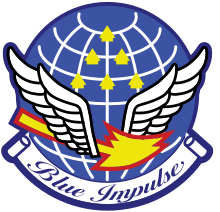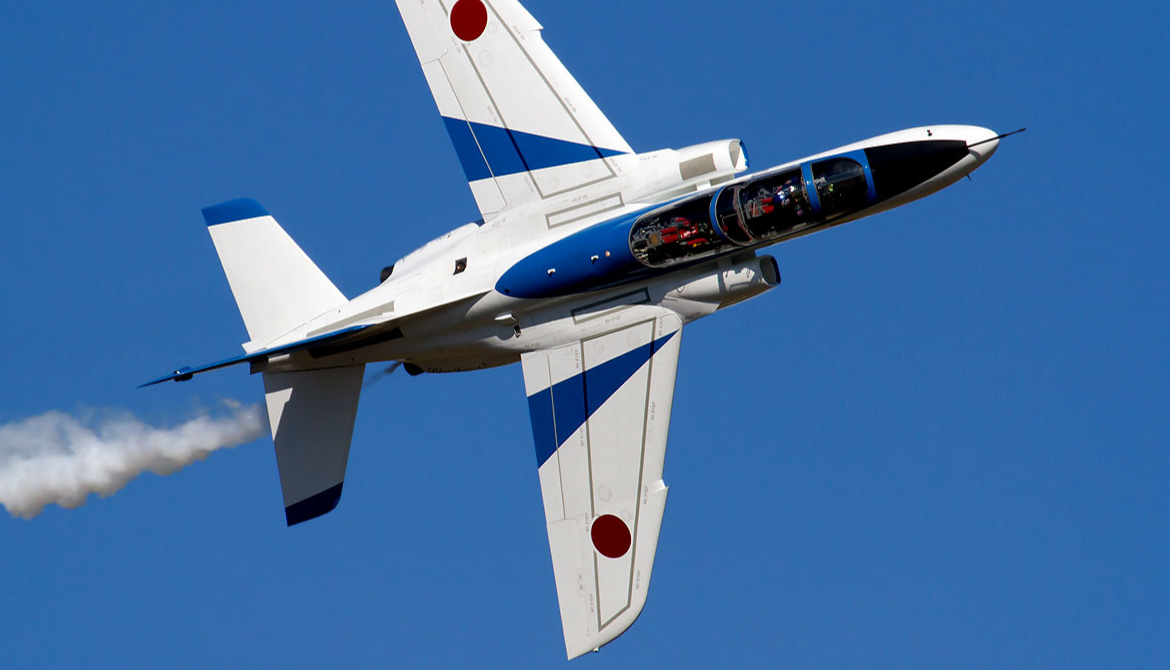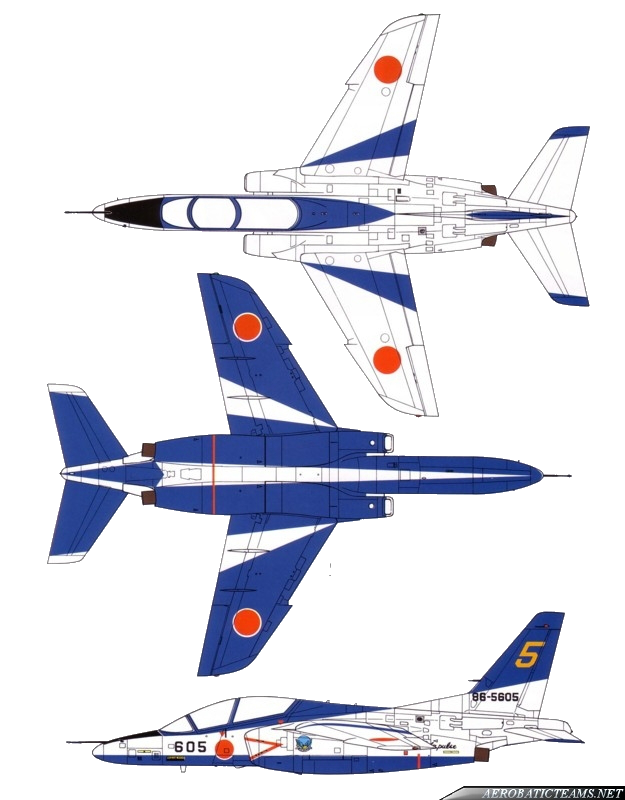
HeadGing 3
Frecce Tricolori Wikipedia link
Heading 6
Blue Impulse (ブルーインパルス, Burū Inparusu) (currently 11 Squadron 4th Air Wing, previously 21 Squadron 4th Air Wing) is the aerobatic demonstration team of the Japan Air Self-Defense Force (JASDF).
Amazing Team Blue Impuls "Japan"
The mercenary air team "Red Impulse" and its leader from the anime series Science Ninja Team Gatchaman take their name from the Blue Impulse. When characters in another anime, Urusei Yatsura, are hit with enough force to send them flying into the distance, they sometimes shout "Blue Impulse!"
Team Blue Impuls "Japan"
Blue Impulse (Burū Inparusu), (currently 11 Squadron 4th Air Wing, previously 21 Squadron 4th Air Wing), is the aerobatic demonstration team of the Japan Air Self-Defense Force (JASDF). The team was founded in 1960 as a team of six F-86 Sabres. They changed mounts to the Mitsubishi T-2 in 1980 and then to the Kawasaki T-4 in 1995. They are based at Matsushima Air Base, which was heavily damaged by the 2011 Tōhoku earthquake and tsunami. The first unofficial Japanese aerobatic team was formed in 1958 at Hamamatsu Air Base, flying Mitsubishi-built North American F-86F Sabres without a special colour scheme, disbanded after four demonstrations.
Created in 1960
|
|||||||||||||||||||||||||||
|
|
||
|
||
|---|---|---|
Team Blue Impuls "Japan"
Birth of the Frecce Tricolori.
Birth of the Frecce Tricolori.)
In 1959 the USAF Thunderbirds visited Japan and inspired JASDF commanders to establish an official aerobatic team. In 1960 the new team was formed at Hamamatsu airbase flying five F-86Fs of 2nd Squadron, with three of the pilots coming from the 1958 team. The first demonstration of the "Tenryū" team, (named after the Tenryū River near the air base), was on 4 March 1960 at Hamamatsu, the name was found to be hard to pronounce in western languages, so the team was renamed Blue Impulse. The aircraft were equipped with smoke generators using five different colours for each aircraft: white, red, blue, green and yellow and painted in silver, light blue, blue and pink; on the leader's aircraft, the blue is replaced by gold. Later, in 1961, all five aircraft received a special paint scheme of overall white with blue flashes. In 1964, Blue Impulse performed at the opening of the 1964 Summer Olympics in Tokyo, drawing the Olympic rings in the air with coloured smoke.
Team Blue Impuls "Japan" history.
Aircraft flown
Fighter
Trainer 9 Kawasaki T-4s present
Former aircraft
North American F-86F Sabre United States 34 1960–1981 JASDF Technical Research Section. 5 aircraft formation.
Mitsubishi T-2 Japan 11 1982–1995 4 AW 21 Sq. Technical Research Section. 6 aircraft formation.
Kawasaki T-4 Japan 11 1995–present 4 AW 11 Sq. 6 aircraft formation.
Photo Gallery
Team Blue Impuls "Japan"
Japan JASDF aircraft
The Japan Air Self-Defense Force (航空自衛隊, Kōkū Jieitai), JASDF (空自, Kūji), also informally referred to as the Japanese Air Force, is the air and space branch of the Japan Self-Defense Forces, responsible for the defense of Japanese airspace, other air and space operations, cyberwarfare and electronic warfare.
Japan Did Not Have A Separate Air Force Before And During World War II. Aviation Operations Were Carried Out By The Imperial Japanese Army Air Service And The Imperial Japanese Navy Air Service (Kōkūtai). Following Defeat In World War II, The Imperial Japanese Army And Navy (Including Their Respective Air Services) Were Disbanded In 1945. Under The Supervision Of The United States Occupation Authorities, A Pacifist Japanese Government Was Appointed In Place Of The Militaristic Governments That Administered The Empire Of Japan During The War.
Aircraft In service
Electronic warfare E-767, EC-1, E-2C/D, YS-11EA/EB
Fighter F-15J/DJ, F-2A/B, F-35A/B
Helicopter UH-60J, CH-47J (LR)
Trainer T-3, T-7, T-400, T-4
Transport C-1, C-2, C-130H, Hawker 800, Gulfstream IV, Boeing 777
Tanker KC-767, KC-130
Aero Vidichody Logo
Aero Vodochody (commonly referred to as Aero) is a Czech aircraft company.

Aero L-39 Albatros
The Aero L-39 Albatros is a high-performance jet trainer, by Aero Vodochody.

Boeing MV-22 Osprey
Bell Boeing V-22 Osprey is an American multi-mission, tiltrotor military aircraft



Kawasaki Heavy Industries Ltd.
Kawasaki T-4 Trainer
About
Kawasaki T-4 Trainer
-
Role Intermediate trainer aircraft National origin Japan Manufacturer Kawasaki
First flight
-
First flight 29 July 1985 Introduction 1988 Primary user Japan Air Self-Defense Force Produced 208+
General Info
- Crew: 2
- Length: 13.00 m (42 ft 8 in)
- Wingspan: 9.94 m (32 ft 7 in)
- Height: 4.60 m (15 ft 1 in)
- Powerplant: 2 × Ishikawajima-Harima F3 -IHI-30 turbofans , 16.32 kN (3,670 lbf) thrust each
Performance
- Maximum speed: 1,038 km/h (645 mph, 560 kn) at sea level
- Stall speed: 167 km/h (104 mph,
- Range: 1,668 km (1,036 mi, 901 nmi) with two 450 L (99 imp gal;
- Service ceiling: 15,240 m (50,000 ft)




